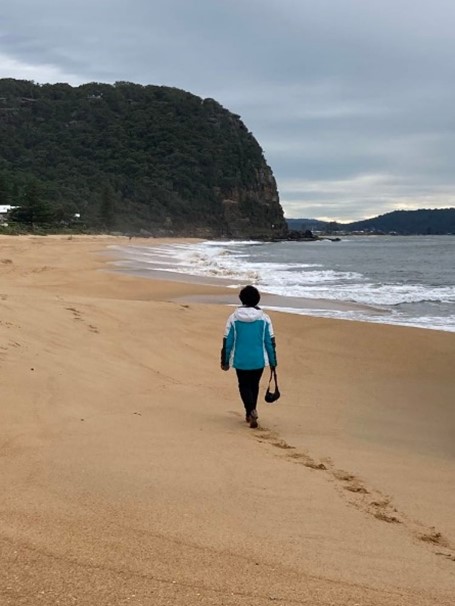Drowning can occur when we are actively on or in water.
Drowning can also happen just by being near water.….
How safe is your beach?
Smita’s Story – a survivor’s voice.

Pearl Beach is a haven away from a busy life for Professor Smita Shah, a Sydney based community physician and part time Pearl Beach resident.
But a simple Sunday walk along Pearl Beach earlier this year almost ended in tragedy!
Smita contracted COVID earlier this year. This was especially confronting for a doctor who understood the risks, had been responsible, yet still contracted the virus. Whilst Smita did not become ill physically her emotional state was affected. She felt anger at contracting COVID, despite doing everything to avoid the virus. It made her ask, ‘Why me.’ Feeling such negative thoughts was foreign to Smita and this made her anxious.
Pearl Beach has always been a source of peace and harmony for Smita, a place to regroup, relax and re-energise. Smita decided to go for a walk on the beach to work through her feelings and thoughts and help raise her spirit. It was a beautiful morning; the sun was shining. There was no one else around. Smita walked along the beach, wondering what life was about and what her next steps should be.
When it was time to return, Smita walked to the water’s edge to wash the sand from her shoes. Suddenly, one of her shoes was washed from her hand by an incoming surging wave. Then, without warning, the sand under her feet slid away and she was plunged into the water.
Smita was totally immersed. As the wave washed over her, she let go. Her mental state had zapped her will to fight for life. It was only a few seconds but strangely this ‘letting go’ may have helped save her. Smita relaxed, she did not panic or struggle so, when the next wave came, it picked her up and deposited her back on the beach. There was an element of sheer luck because, if the waves had been bigger that day, a very different outcome could have occurred.
Not everyone has been as lucky as Smita was. In July 2014, a 5-year-old boy was playing by the water’s edge on the dangerous northern end of the beach, a surging wave washed him into water. Sadly, he lost his life. In March 2021, a man was walking his dog along the beach, when a surging wave dragged the dog into the water and as the man went to assist, he lost his life.
Two people lost their lives, Smita nearly lost hers. None of these people were swimming, yet two drowned and one survived. Alarmingly, there are also others who have stories to tell of the surging waves, a shifting sand and being dragged into the deep, deep water.
The enormity of what had happened, of Smita’s survival when tragedy could have resulted, left her weeping at the water’s edge. The idea that she could just let go scared her. She reached out to a friend who helped her work through the before and after her near-drowning survival.
For Smita, this event was a catalyst to re-finding her mojo and regaining her positive outlook. Thankfully, Smita has able to turn this experience into a positive and is back to her optimistic self. This year she was awarded an Order of Australia (OAM) Medal for her work in community health.
Smita feels it is important to share her story to help others understand the dangers. When asked what she took away from her frightening experience, Smita responded, ‘People need to be aware of the dangers around Pearl Beach. To me, the conditions seemed really safe and the waves calm but the sand can give away and everyone needs to be careful.’
So, what makes Pearl Beach so dangerous?
The sand is coarse, containing quartz crystal from the sandstone cliffs surrounding the community. Coarse sand will easily move from under your feet. There is also a sudden drop off into deep water.
Pearl Beach faces the opening of Broken Bay to the ocean. When there is a south or southeast swell the waves travel 3km directly onto Pearl Beach. These waves are generally the more dangerous surging, plunging (dumping) waves with a strong backwash that can drag you back into the deep water.

Sand cusps, which are the rises of sand along the beach, are an indication of surging waves. The middle to northern end of the beach are the most dangerous areas as they will have surging waves even when the swell is low. The southern end, whilst safer, is unpatrolled and has a drop off into deep water. It is still dangerous, especially for children and older persons.

How can you keep yourself and loved ones safe?
- Before going to the beach, check the weather and surf conditions. Willy Weather and Beach Safe are the sites I use. You can down load the app for Beach Safe or visit www.beachsafe.org.au
- Stop and look for potential hazards when you arrive at the beach, even if you are only planning to walk
- Swim at a patrolled beach between the red and yellow flags
- Never swim alone and know your abilities and only enter the water if it is safe to do so
- If you get into difficulties in the water, signal for help, relax, float, and await assistance
- If you see someone who needs help, call 000 for assistance – do not enter the water unless you have the skills and equipment to safely do so
- If there are surging waves, do not walk close to the water’s edge
- Supervise children at all times, on, in and around water
- When boating, rock fishing and on watercraft wear a lifejacket
- Avoid alcohol and drugs when around water
Safety – it’s everyone’s’ responsibility.



Leave a Comment